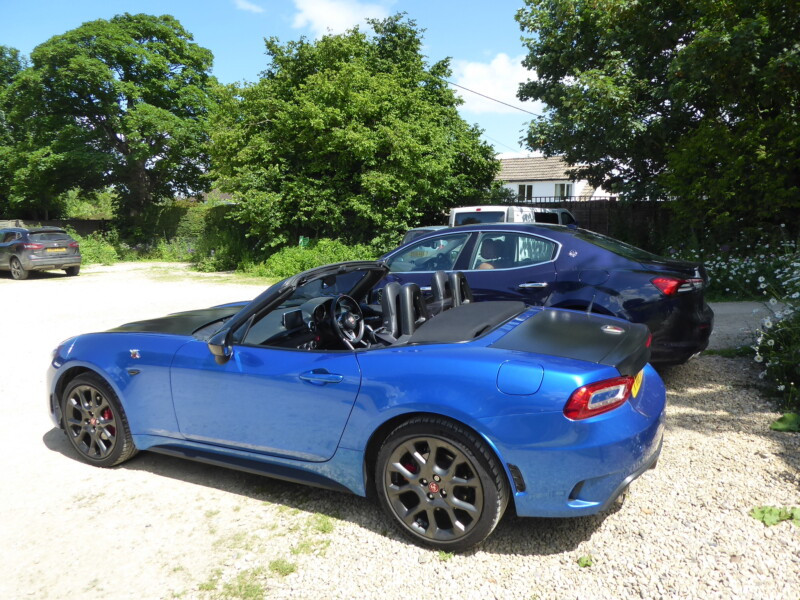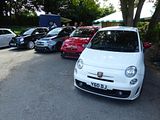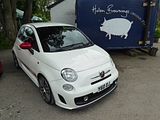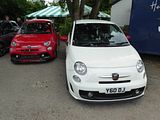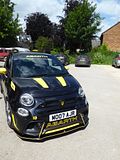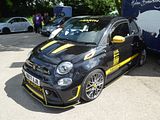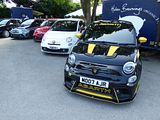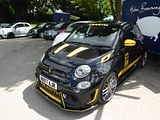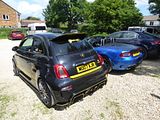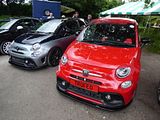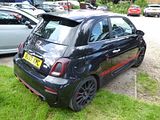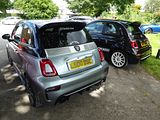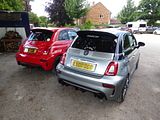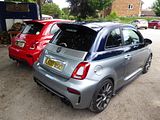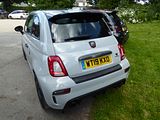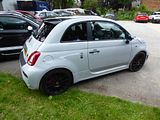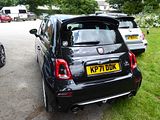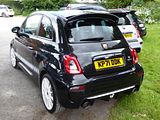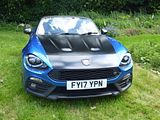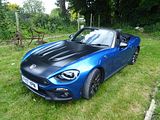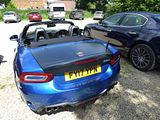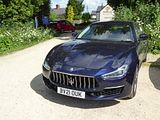Whilst a large event with lots of cars spread over an expansive venue is always a pleasure, it does not really qualify as a relaxing day out. So sometimes, it is nice to do something quite different that involves cars and car friends. All it takes is a nice venue, preferably one that serves food and drink and a group of people, brought together by a shared love of things automotive can a most agreeable day out. And that’s exactly what the gathering covered in this brief report is all about. The event was organised by Abarth Berkshire, though the venue actually in the adjacent county of Wiltshire. The Helen Browning’s Royal Oak Inn is one of those places that you almost certainly would not find by accident, but to which you most certainly will want to return to on purpose. It’s in a little village called Bishopstone only a few miles off the M4 to the east of Swindon. I’m not quite sure how, as a group, we became aware of it, though I do recall that earlier in the year when we met at Stanton House, only a few miles away and there was not enough capacity for food, so those who were hungry did some quick research on Google and found this pub with a lot of good reviews. Their positive reports certainly suggested it was worth all of us going there, a decision that was reinforced when we learned that the venue is very happy to welcome Car Clubs and had recently accommodated around 180 of them on site. Two of the Berkshire Admin team, both of whom actually live in the Swindon area, conducted the discussions with the pub and having agreed a date, told us all that the landlord said we could have our own area and they would even bring in a burger facility outdoors to avoid us having to wait for what may have been a busy kitchen. Although this was more of a people day than a car day, it would have been an opportunity missed not to look at take pictures of the cars, and here they are:
Oldest of the cars here was the 595 model belonging to Abarth Berkshire founder and Lead, DJ Lewis. He’s done quite a lot of work on it, modifying it for more power and much more noise (as I can attest, having followed him on a convoy more than once!) and he’s changed a few of the external details to those of the later Series 4 cars, something many people have done and which call for a certain amount of head-scratching in years to come as the cars age. It used to be relatively easy to identify a 500-based Abarth. When the model was first launched, as there was only one version as shipped ex works called the 500. It had a 135 bhp 1.4 litre turbo-charged engine coupled to a five speed manual gearbox, with 16″ alloys as standard, and the option of 17″ wheels, and a colour palette comprising of two whites (BossaNova White, the standard colour, or the pearlescent Funk White), Red (Pasadoble), Pale Grey (Campovolo) or Black. If you wanted more power – 160 bhp – then you could order an Esseesse kit, which came in a large wooden crate, containing new wheels, springs, an ECU upgrade, the Monza exhaust system and badging. It was dealer fitted and could be applied at any time within the first 12 months or 10,000 miles from registration. Needless to say, it proved popular. As were many of the optional extras, with stickers for the sides, a large scorpion for the bonnet and even a chequered pattern for the roof among the personalisation options offered. Having used the legendary 695 badging from the 1960s on the Tributo cars, at the 2012 Geneva Show, Abarth dusted off the 595 name that had been used on the less powerful of the Nuova 500 based cars of the same generation, and created two new versions which we should think of as Series 2 cars, the 595 Turismo and Competizione, both of which could be bought in either closed or open top C guise, with either the 5 speed manual or robotised automated gearshifts. Both models had the 160 bhp engine as standard. Effectively they were a replacement for the Esseesse kit, and it meant that the cars were produced complete at the factory, rather than needing the dealer to undertake the upgrade (and the associated paperwork), though Abarth did not withdraw the Esseesse kits from the market for some while. Turismo, as the name suggests was aimed slightly less extreme in intent, featuring standard leather upholstery, upgraded dampers and climate control, Xenon headlights and Alutex interior details. The sportier Abarth 595 Competizione replaced the leather seats with Sabelt cloth sport seats and Alutex with aluminium, while adding p-cross-drilled brakes and the Record Monza dual-mode exhaust. Some new colours were introduced, and very soon one of those, Record Grey, frequently combined with a tan interior became one of the most popular choices. There were several examples of this popular colour here and there is no denying that this combination suits the Abarth shape very well. Bossa Nova White has been the no charge colour for a while, so there are a lot of cars painted this way, and DJ’s car is one such.
What is known as the Series 4 version of the familiar 595 reached the markets in the middle of 2016. After rumours had circulated all winter following the launch of the facelifted Fiat 500 last year, Abarth finally unveiled the Series 4 at the end of May 2016. Initially, we were told that the cars would not be available in the UK until September, but that came forward somewhat, with dealers all receiving demo cars in June, and the first customers taking delivery in July. Three regular production versions of both the closed car and the open-topped C were initially available, all badged 595, and called Custom, Turismo and Competizione, as before, though numerous limited edition models have since appeared and in most case disappeared. The most significant changes with the Series 4 are visual, with a couple of new colours, including the much asked for Modena Yellow and a different red, called Abarth Red, which replaces both the non-metallic Officina and – slightly surprisingly – the tri-coat pearlescent Cordolo Red. as well as styling changes front and rear. The jury is still out on these, with many, me included, remaining to be convinced. At the front, the new air intake does apparently allow around 15 – 20 % more air in and out, which will be welcome, as these cars do generate quite a lot of heat under the bonnet. Competizione models for the UK retain the old style headlights, as they have Xenon lights as standard, whereas the Custom and Turismo cars have reshaped units. At the back, there are new light clusters and a new rear bumper and diffuser. Inside, the most notable change is the replacement of the Blue & Me system with a more modern uConnect Audio set up, which brings a new colour screen to the dash. Mechanically, there is an additional 5 bhp on the Custom (now 145) and Turismo (now 165 bhp) and the option of a Limited Slip Diff for the Competizione, which is likely to prove a popular option. Details of the interior trim have changed, with a filled-in glovebox like the US market cars have always had, and electric windows switches that are like the US ones, as well as a part Alcantara trim to the steering wheel in Competizione cars. Mark Rosales’ car is of this generation, but like so many others, he has also done a lot of mods to it, so it is now very far from standard as these pictures evidence. The combination of the Nero Scorpione (black) paint and yellow detailing is a particularly good one in the eyes of many.
There have been a now bewildering array of different models, some more limited in number than others over the years. In 2017 Abarth added two more to the range. The pricey exclusive model was the £20,360 695 Yamaha XSR inspired by the brand’s MotoGP sponsorship, while the £17,360 595 Trofeo came long to slot between the base £15,260 Abarth 595 and the £18,360 595 Turismo as a permanent addition. The Trofeo provides a 158bhp, 169lb ft version of the 1.4 T-Jet turbo engine, 15bhp more than in the standard Abarth 595 and only 5bhp less than the Turismo’s 163bhp. It’s a trivial power difference, the two powertrains delivering identical torque and the same 7.3sec 0-62mph time, although you’ll go just over 1mph faster with 163 horses. But you’ll beat the base 595 to 62mph by 0.5sec. The Trofeo package also provides more hardware. Over the standard 595 you get bigger 17in alloys, a dual-mode, quad-pipe exhaust system (grandly titled ‘Dual Record Monza exhaust’), perforated front discs and Koni rear dampers. These feature the famous Dutch shock absorber brand’s frequency-selective damping (FSD), the non-Koni front struts also having FSD. Each damper features an extra internal oil-way to improve their handling of high-frequency bumps that affect ride, without compromising the suspension’s ability to deal with the low-frequency wheel inputs required for good roadholding. So it’s claimed, anyway, although there’ll be moments when you question the effectiveness of these modifications when the ride turns turbulent. The Trofeo’s interior is essentially the same as that of other Abarth 500s. The Trofeo’s seats are attractively styled with six large circular perforations and Abarth stitching to the head restraints, the wheel is leather-rimmed and the 7.0in U-Connect infotainment system includes some basic telemetry. There were two examples here: the red car belonging to Courtney Giles-Buchanan and the black one to Owen John. Again, both have personalised their cars somewhat so neither are quite how they left the factory.
Also here was a lovely 695 Rivale, this one being the proud possession of Larissa Desciscio. This model is the latest celebration of Fiat’s partnership with Riva, which has already seen a special Riva version of the 500,. Described as being “the most sophisticated Abarth ever”, it is available either as a hatch or a cabriolet, with both of them featuring a two-tone Riva Sera Blue and Shark Grey paintwork. The Rivale is adorned with an aquamarine double stripe, satin chrome finish on the door handles and satin chrome moulding on the tailgate, various aesthetic elements inspired by the Riva 56 Rivale yachts and ‘695 Rivale’ logos, joined by Brembo Brakes, Koni suspension, and 17-inch Supersport alloy wheels. Enhancing the nautical theme the new 695 Rivale features either a carbon fibre or mahogany dashboard, black mats with blue inserts, blue leather seats and door panels, carbon fibre kick plates, special steering wheel wrapped in blue and black leather and with a mahogany badge, blue leather instrument panel cover, and mahogany gear lever knob and kick plate. These are joined by the standard Uconnect infotainment with a 7-inch display, which is compatible with Android Auto and Apple CarPlay, and there is also a hand-written numbered plate that can be customised with the mane of the customer’s yacht on request. Powering the 695 Rivale is the same 1.4-litre turbocharged engine that makes 180PS (177hp) and 184lb/ft of torque, that features in the 595 Competizione, allowing it to go from rest to 100km/h (62mph) in 6.7 seconds and up to a top speed of 225km/h (140mph). This is a regular model in the range, but confusingly, there is also the Abarth 695 Rivale 175 Anniversary, created to celebrate 175 years of the Riva brand. Just 350 of these were produced, half of them the hatch and the other half cabriolets. These featured 17-inch alloy wheels with a special pattern, celebratory badge on the outside, hand-crafted details such as the two-tone colour – blue and black hand-stitched leather seats with a celebratory logo stitched onto the headrest, carbon dashboard silk screen printed with special logo, numbered plate. Standard Rivale cars arrived in the UK in April, and quite a few have been sold. They always attract lots of interest when they do appear.
Most recently, the top of the range has seen the return of the Esseesse badging, but this time the car comes like this from the factory rather than relying on the dealer to fit the upgrades. The 595 Esseesse was launched early in 2019. In essence this is similar to a 595 Competizione, but with almost every item of equipment included as standard The Esseesse specifically gains a mechanical limited slip differential, a new dual exit exhaust system from specialists Akrapovic, high-performance Brembo front brakes, eye-catching, bright white multispoke 17-inch alloy wheels and a pair of huge carbon-fibre backed bucket seats from Sabelt. Elsewhere, it’s sprung by Koni Frequency Selective Damping suspension front and rear and is wrapped up in the latest 595 bodykit. The 595 Esseesse is available with either the hatch or the cabrio body though there are very few of the latter in the UK. The car seen, in the long-lived and popular colour of Campovolo Grey, belongs to Rob McCarthy.
In July 2021, Abarth announced a 695 Esseesse and Pete Burgess, as we now know spend some time, trying to source one to replace his 595 Esseesse, itself a second Abarth as hen I first met him he had a Modena Yellow car. He finally located this one in the East Midlands, and surprised us all earlier in the year when he arrived at a meet in it. It’s a limited-edition version of the Italian brand’s compact hot hatchback which, thanks to some lightweight panels and some extra aero, is now the fastest model in the company’s line-up. Production was limited to just 1,390 examples, with 695 units coming in Scorpion black and 695 in Campovolo grey. The car was not cheap, listing at a little over £30,000, meaning the car was only ever going to appeal to he real brand enthusiast. Tweaks include white 17-inch alloys, uprated Koni FSD shock absorbers, red Brembo brake calipers and exclusive white detailing for the front splitter and rear diffuser. There’s also an Akrapovic exhaust system and a new aluminium bonnet, which saves 10kg over the standard Abarth 595 Competizione. The Abarth 695 Esseesse also features the same manually adjustable tailgate spoiler we first saw on the 695 70th Anniversario. Buyers can alter the wing’s angle of attack from zero to 60 degrees, with the most aggressive setting offering an extra 42kg of downforce. It’s powered by a turbocharged 1.4-litre four-cylinder petrol engine, which develops 178bhp and 250Nm of torque. Thanks to the wright reduction the car will sprint from 0-62mph in 6.7 seconds and reach a top speed of 140mph with the wing angle set to zero degrees. Every example will also come with a five-speed manual gearbox. Abarth’s exclusive styling touches continue inside with a pair of Sabelt bucket seats, with embroidered “one of 695” monograms on the headrests. The gear knob has also been swapped for a carbon fibre replacement, while the dashboard is trimmed in Alcantara and features a laser-cut “695 Esseesse” badge on the passenger side.
There was just one example of the 124 Spider here, this car belonging to Jeremy Ingham. He bought it around a year ago, having found his previous BMW a bit underwhelming and having heard very positive things about the Abarth community. He has repeatedly said that the switch was a good one, as he loves the car and has thrown himself into community activities, quickly becoming one of the Admin team. Eagerly awaited, the 124 Spider went on sale in September 2016. A quick reminder as to what this car is: The Abarth 124 Spider was developed in parallel with the Fiat model. It does cost a lot more, and there are those who think you don’t get enough extra for your money, but those who have driven it will tell you otherwise. You certainly get more power. The 1.4 MultiAir turbo unit jumps up from 138bhp to 168bhp, while torque also increases by a modest 10Nm to 250Nm, which gives it a 0-62mph time of 6.8 seconds, which is half a second quicker than the 2.0-litre Mazda MX-5. The top speed is 143mph. It weighs just 1060kg meaning a power-to-weight ratio of 158bhp-per-tonne, and with the new Record Monza exhaust system it sounds great even at idle. The Abarth version gets a stiffer suspension setup than the regular Fiat 124 Spider, with Bilstein dampers and beefed-up anti-roll bars. Bigger Brembo brakes also feature, with aluminium calipers. It can be had with a six-speed manual or six-speed automatic transmission with paddles, and the latter gets a Sport mode for quicker shifts. Many of the UK cars sport the ‘Heritage Look’ pack, which is a no-cost option. It brings a matt black bonnet and bootlid, plus red exterior trim detailing and has proved popular. The £29,565 starting price gets you standard equipment such as cruise control, climate control, Bluetooth, a DAB radio and satnav, plus Alcantara black and red (or pure black) seat trim. The automatic gearbox is a £2,035 extra, while an optional visibility pack brings LED DRLs, auto lights and wipers and rear parking sensors. The final cars were sold during 2019, so there are only around 1800 of them in the UK, which means that this is always going to be quite a rare sighting.
Final car here from our group was not an Abarth, but was it was mine, it was allowed to join in. Logistics meant that I had been in the Midlands overnight in the Ghibli and to this event directly from there, and anyway, most of the group are just as happy to see a bigger Italian car as they are for me to bring the Abarth!
The chosen day was one of the hotter ones of the summer, so the garden with shady areas was a very pleasant place in which to spend some time. There was certainly plenty of time to chat and to relax as these pictures of a couple of the attendees show!
This was a most agreeable day and a timely reminder that the big events are not the only way to enjoy cars and the pleasure of the company of friends. I have no doubt that we will be back at this appealing venue just as soon as there is space in the diary to do so.

